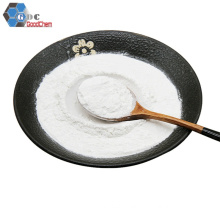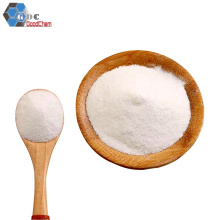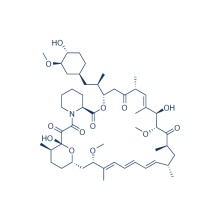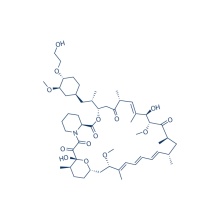.cp_wz tabla {borde superior: 1px sólido #ccc; borde izquierdo: 1px sólido #ccc; } .cp_wz table td {borde derecho: 1px sólido #ccc; borde inferior: 1px sólido #ccc; padding: 5px 0px 0px 5px;} .cp_wz table th {border-right: 1px solid #ccc; border-bottom: 1px solid #ccc; padding: 5px 0px 0px 5px;} \ n Peso molecular: 455,5 XL388 es un inhibidor de mTOR altamente potente, selectivo y competitivo con ATP con IC50 de 9,9 nM, selectividad 1000 veces mayor que las quinasas PI3K estrechamente relacionadas. \ n En MCF- 7 células, XL388 bloquea la fosforilación de mTORC1 de p70S6K (T389) con un valor de IC50 de 94 nM y bloquea la fosforilación de mTORC2 de AKT (S473) con un valor de IC50 de 350 nM. In vitro, XL388 inhibe la viabilidad de líneas celulares tumorales sólidas y hematopoyéticas. La IC50 de proliferación es 1,37 µM en la línea celular MCF-7. XL388 también actúa en sinergia con quimioterápicos en ensayos basados en células para bloquear la viabilidad celular. Cuando se dosifica por vía oral una vez al día en ratones, XL388 muestra una fuerte actividad antitumoral en múltiples modelos de xenoinjerto que incluyen> 100% de inhibición del crecimiento tumoral en el modelo de xenoinjerto MCF-7. XL388 muestra una buena farmacocinética y exposición oral en múltiples especies con biodisponibilidad moderada. La unión a proteínas plasmáticas media de XL388 en plasma humano, mono, perro, rata y ratón se evalúa a 5 μM y se determina que es 86%, 90%, 89%, 85% y 84%, respectivamente. La administración oral de XL388 a ratones desnudos atímicos implantados con xenoinjertos de tumores humanos proporcionó una actividad antitumoral significativa y dependiente de la dosis. Se logra una fuerte inhibición de mTORC1 y mTORC2 4 a 8 h después de la administración oral a 100 mg / kg. También se observa una modesta inhibición (39-45%) de la fosforilación de la AKT diana PI3K (T308) 4 a 8 h después de la dosis. \ n \ n
|
mTOR ELISA Assay
|
The measurement of mTOR enzyme activity is performed in an ELISA format following the phosphorylation of 4E-BP1 protein. All experiments are performed in the 384-well format. Generally, 0.5 μL of DMSO containing varying concentrations of the test compound is mixed with 15 μL of the enzyme solution. Kinase reactions are initiated with the addition of 15 μL of a solution containing the substrate. The assay conditions are as follows: 0.2 nM mTOR, 10 μM ATP, and 50 nM NHis-tagged 4E-BP1 in 20 mM Hepes, pH 7.2, 1 mM DTT, 50 mM NaCl, 10 mM MnCl2, 0.02 mg/mL BSA, 0.01% CHAPS, 50 mM β-glycerophophate. Following an incubation of 120 min at ambient temperature, 20 μL of the reaction mixture is transferred to a Ni-chelate-coated 384-well plate. The binding step of the 4E-BP1 protein proceeded for 60 min, followed by washing four times each with 50 μL of Tris-buffered saline solution (TBS). Anti-phospho-4E-BP1 rabbit immunoglobulin G (IgG; 20 μL, 1:5000) in 5% BSA−TBST (0.2% Tween-20 in TBS) is added, and the reaction mixuture is further incubated for 60 min. Incubation with a secondary horseradish peroxidase (HRP)-tagged anti-IgG is similarly performed after the primary antibody is washed off (four washes of 50 μL). Following the final wash step with TBST, 20 μL of SuperSignal ELISA Femto is added and the luminescence measured using an EnVision plate reader.
|
Estudio con animales: [2]
|
Animal Models
|
MCF-7 xenograft tumors
|
|
Formulation
|
solution/fine suspension in water (with a 1:1 molar ratio of 1 N HCl)
|
|
Dosages
|
50, 100 mg/kg once daily
|
|
Administration
|
Orally
|
|
Solubility
|
30% PEG400/0.5% Tween80/5% propylene glycol,
30 mg/mL
|
|
* Please note that Selleck tests the solubility of all compounds in-house, and the actual solubility may differ slightly from published values. This is normal and is due to slight batch-to-batch variations.
|
Conversión de diferentes modelos de animales basados en BSA (valor basado en datos del Borrador de Directrices de la FDA)
|
Species
|
Baboon
|
Dog
|
Monkey
|
Rabbit
|
Guinea pig
|
Rat
|
Hamster
|
Mouse
|
|
Weight (kg)
|
12
|
10
|
3
|
1.8
|
0.4
|
0.15
|
0.08
|
0.02
|
|
Body Surface Area (m2)
|
0.6
|
0.5
|
0.24
|
0.15
|
0.05
|
0.025
|
0.02
|
0.007
|
|
Km factor
|
20
|
20
|
12
|
12
|
8
|
6
|
5
|
3
|
|
Animal A (mg/kg) = Animal B (mg/kg) multiplied by
|
Animal B Km
|
|
Animal A Km
|
Por ejemplo, para modificar la dosis de resveratrol utilizada para un ratón (22,4 mg / kg) a una dosis basada en el BSA para una rata, multiplique 22,4 mg / kg por el factor Km para un ratón y luego divida por el factor Km para una rata. Este cálculo da como resultado una dosis equivalente para ratas de resveratrol de 11,2 mg / kg.
|
Rat dose (mg/kg) = mouse dose (22.4 mg/kg) ×
|
mouse Km(3)
|
= 11.2 mg/kg
|
|
rat Km(6)
|
\ n Información química
|
Molecular Weight (MW)
|
455.5
|
|
Formula
|
C23H22FN3O4S
|
|
CAS No.
|
1251156-08-7
|
|
Storage
|
3 years -20℃Powder
|
|
6 months-80℃in solvent (DMSO, water, etc.)
|
|
Synonyms
|
N/A
|
|
Solubility (25°C) *
|
In vitro
|
DMSO
|
23 mg/mL
(50.49 mM)
|
|
Water
|
<1 mg/mL
(
|
|
Ethanol
|
<1 mg/mL
(
|
|
In vivo
|
30% PEG400/0.5% Tween80/5% propylene glycol
|
30 mg/mL
|
* <1 mg/ml means slightly soluble or insoluble.
* Please note that Selleck tests the solubility of all compounds in-house, and the actual solubility may differ slightly from published values. This is normal and is due to slight batch-to-batch variations.
|
|
Chemical Name
|
Methanone, [7-(6-amino-3-pyridinyl)-2,3-dihydro-1,4-benzoxazepin-4(5H)-yl][3-fluoro-2-methyl-4-(methylsulfonyl)phenyl]-
|
Calculadora de molaridad Calculadora de dilución Calculadora de peso molecular
Grupos de Producto : PI3K / Akt / mTOR > Inhibidor de mTOR









